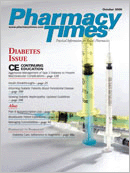Publication
Article
Pharmacy Times
Drugs for Rare Diseases Are Coming to Market
Author(s):
The Federal Food, Drug, andCosmetic Act defines an orphandrug as one with efficacy against adisease affecting fewer than 200,000 peoplein the United States or one that scientistsand economists at the FDA determinewill not be profitable for 7 years afterFDA approval.1 Axiomatically, therefore, arare disease is one that affects fewer than200,000 people in the United States. Morethan 5000 different types may exist, rangingfrom Aarskog syndrome to Zellwegersyndrome. Over 20 million Americansmay be affected by them.
A sad example of someone with a raredisease is Mattie Stepanek, the youngpoet and poster boy for the Jerry LewisTelethon. Along with his 3 siblings, hedied from a type of muscular dystrophycalled dysautonomic mitochondrialmyopathy. His mother also was recentlydiagnosed with the adult-onset versionof the disease.
A rare disease database, with reportson >1150 diseases compiled by theNational Organization for Rare Disorders(NORD), is available on its Web site,http://rarediseases.org. NORD also suppliesinformation on >2000 patientorganizations or support groups thathelp patients with rare diseases.
If the rare disease is caused by a single-gene disorder, an excellent resourcefor information is provided by theNational Institutes of Health(NIH). Online MendelianInheritance in Man (www.ncbi.nlm.nih.gov/omim) providesdetailed clinical reviewsfor 14,184 single-gene disorders,together with the latestgenetic research.2 Accordingto the NIH, ~1000 genetictests are now available for avariety of diseases and conditions,and the number oftests is still growing. Most ofthese tests are used for newbornsor for families with astrong history of a disease.
It has been estimated that80% of rare diseases aregenetic in origin, and anincreased understanding of genetics hasled to a growing awareness that studyingrare diseases often contributes toknowledge of more common ones.3 Thisarticle will discuss information aboutwhich pharmacists should be aware,including (1) the causes and effects ofrare diseases; (2) the Orphan Drug Actand how drugs to treat rare diseases areapproved, even though the usual standardsof scientific evidence often areunderpowered; and (3) ongoing researchstudies on rare diseases.
Causes and Effects
As mentioned above, recent researchconfirms that most rare diseases aregenetic in origin. They are ultimatelytraceable to pairs of genes. Thesegenes, which are the functional units ofDNA, are strung by the hundreds orthousands along the 23 pairs of chromosomesin the nucleus of each cell inthe body. Altogether they make up thegenome, or complete code of inheritance.Each gene codes for a particulartrait, the result of the underlying proteinsthat produce the trait.
Occasionally, a variation can occur inthe making of a gene. If the error is in aparticularly critical location and producesa destructive change in bodychemistry, the fetus will die early in thegestation process. If the genetic alterationrepresents only a small deviation,however, it may survive to be passedon to the next generation as a new traitor as a genetic disease.4
The Orphan Drug Act
Rep Henry Waxman (D, Calif) was primarilyresponsible for the enactment ofthe Orphan Drug Act. Early in 1982, heintroduced a bill offering incentives toentice drug companies to increase theirresearch on rare diseases. At the hearingsheld to discuss the bill, several hundredvictims of rare disorders along with theirrespective support groups offered support.
Less than 1 year later, on January 4,1983, President Ronald Reagan signedthe bill into law. Incentives for pharmaceuticalcompanies included substantialtax breaks and rights to market resultingdrugs exclusively for 7 years. Congressalso mandated that funds be available toacademic researchers and pharmaceuticalfirms to conduct research into rarediseases under the FDA Orphan DrugGrant Program. Additionally, a marketingapplication for a prescription drug productthat has been designated as a drugfor a rare disease or condition is not subjectto a prescription drug user fee unlessthe application includes an indication forother than a rare disease or condition.
In the intervening years since the lawwas passed, 282 orphan drugs and biologicalproducts, providing treatment formore than 14 million patients, have cometo market. In the 8 to 10 years before1982, only 10 treatments for rare diseaseshad been approved by the agencyand brought to market.1
Because of the limited number ofpatients diagnosed with a rare diseaseand the inability to recruit sufficientpatients, the current method for clinicaltrials (hypothesis testing) cannot detect orexclude clinically worthwhile differencesbetween treatments with standard levelsof statistical confidence. Clinicians mustrely on observational studies, historicalcontrols, anecdotal information, limitedclinical experience, and the perception ofbiological plausibility.5 The problem hasbeen partially solved by changing the levelof statistical certainty and employing theBayesian approach. This method enumeratesthe probabilities of effects of differentsizes, and the trial is analyzed as dataaccumulate.6
Small patient populations have thus farnot presented a major problem in theapproval process. For example, the clinicaltrial for bovine pegademase (Adegen)used in the treatment of severe immunodeficiencysyndrome of the adenosinedeaminase type involved just 8 patients,and only 14 people had the disease at thattime. A historical control was used in thetrial, and the drug proved 100% effective.1
Ongoing Research
A number of rare disease studies currentlyare enrolling patients. Studiesinclude argininosuccinate lyase deficiency,Rett syndrome, polyarteritis nodosa,Wegener's granulomatosis, Churg-Strauss syndrome, heparin-inducedthrombocytopenia, Angelman's syndrome,Andersen-Tawil syndrome, myelodysplasticsyndromes, and large granularlymphocyte leukemia. Other studies thatwill begin later include trials for rare lungdiseases, thrombotic defects, and ureacycle disorders. A complete list can befound on the Rare Diseases ClinicalResearch Network Web site.7 Other informationregarding orphan drug designationsand approvals is available on theFDA's Web site.8
Mr. Sherman is president of ShermanConsulting Services Inc.
For a list of references, send a stamped,self-addressed envelope to: ReferencesDepartment, Attn. A. Rybovic, PharmacyTimes, Ascend Media Healthcare, 103 CollegeRoad East, Princeton, NJ 08540; or send ane-mail request to: [email protected].







